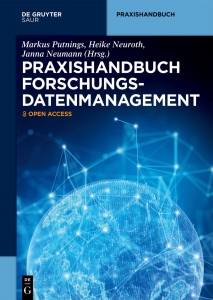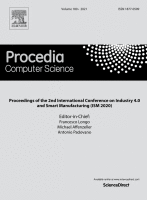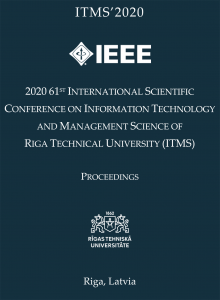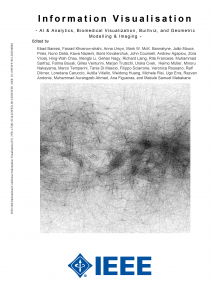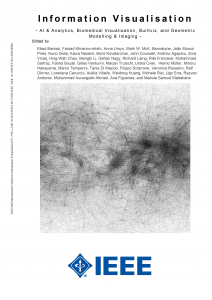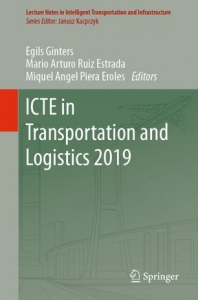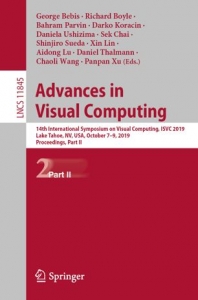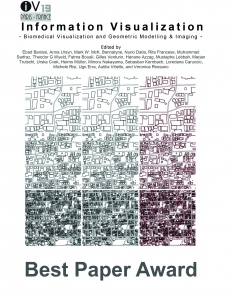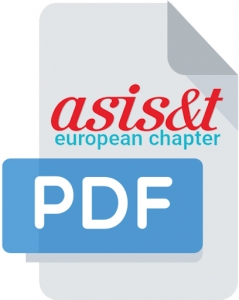Publikationen
Sina, Lennart; Burkhardt, Dirk; Nazemi, Kawa Visual Dashboards in Trend Analytics to Observe Competitors and Leading Domain Experts Proceedings Article In: Afli, Haithem; Bleimann, Udo; Burkhardt, Dirk; Loew, Robert; Regier, Stefanie; Stengel, Ingo; Wang, Haiying; Zheng, Huiru (Jane) (Hrsg.): Proceedings of the 6th Collaborative European Research Conference (CERC 2020), S. 222-235, CEUR-WS.org, Aachen, Germany, 2021, ISSN: 1613-0073, (urn:nbn:de:0074-2815-0). Abstract | Links | BibTeX | Schlagwörter: Business intelligence, information exploration, Innovation Management, Visual analytics, Visual Trend Analysis Nazemi, Kawa; Kaupp, Lukas; Burkhardt, Dirk; Below, Nicola Datenvisualisierung Buchkapitel In: Heike Neuroth Markus Putnings, Jana Neumann (Hrsg.): Praxishandbuch Forschungsdatenmanagement, Kapitel 5.4, S. 477–502, De Gruyter, 2021, ISBN: 978-3-11-065365-6. Abstract | Links | BibTeX | Schlagwörter: Kaupp, Lukas; Webert, Heiko; Nazemi, Kawa; Humm, Bernhard; Simons, Stephan CONTEXT: An Industry 4.0 Dataset of Contextual Faults in a Smart Factory Artikel In: Procedia Computer Science, Bd. 180, S. 492-501, 2021, ISSN: 1877-0509, (Proceedings of the 2nd International Conference on Industry 4.0 and Smart Manufacturing (ISM 2020)). Abstract | Links | BibTeX | Schlagwörter: anomaly detection, contextual faults, cyber-physical systems, fault diagnosis, smart factory Nazemi, Kawa; Kowald, Matthias; Dannewald, Till; Burkhardt, Dirk; Ginters, Egils Visual Analytics Indicators for Mobility and Transportation Proceedings Article In: Grabis, Janis; Romanovs, Andrejs; Kulesova, Galina (Hrsg.): 2020 61st International Scientific Conference on Information Technology and Management Science of Riga Technical University (ITMS), S. 1-6, IEEE, 2020, ISBN: 978-1-7281-9105-8. Abstract | Links | BibTeX | Schlagwörter: Artificial Intelligence, Mobility, Visual analytics Aizstrauts, Artis; Burkhardt, Dirk; Ginters, Egils; Nazemi, Kawa On Microservice Architecture Based Communication Environment for Cycling Map Developing and Maintenance Simulator Proceedings Article In: Grabis, Janis; Romanovs, Andrejs; Kulesova, Galina (Hrsg.): 2020 61st International Scientific Conference on Information Technology and Management Science of Riga Technical University (ITMS), S. 1-4, IEEE, 2020, ISBN: 978-1-7281-9105-8. Abstract | Links | BibTeX | Schlagwörter: Easy Communication Environment, microservice architecture, Simulation Burkhardt, Dirk; Nazemi, Kawa; Ginters, Egils Innovations in Mobility and Logistics: Assistance of Complex Analytical Processes in Visual Trend Analytics Proceedings Article In: Grabis, Janis; Romanovs, Andrejs; Kulesova, Galina (Hrsg.): 2020 61st International Scientific Conference on Information Technology and Management Science of Riga Technical University (ITMS), S. 1-6, IEEE, 2020, ISBN: 978-1-7281-9105-8. Abstract | Links | BibTeX | Schlagwörter: Adaptive visualization, logistics, Process Mining, Transportation, Trend Analytics, Visual analytics Banissi, Ebad; Khosrow-shahi, Farzad; Ursyn, Anna; Bannatyne, Mark W. McK.; Pires, João Moura; Datia, Nuno; Nazemi, Kawa; Kovalerchuk, Boris; Counsell, John; Agapiou, Andrew; Vrcelj, Zora; Chau, Hing-Wah; Li, Mengbi; Nagy, Gehan; Laing, Richard; Francese, Rita; Sarfraz, Muhammad; Bouali, Fatma; Venturin, Gilles; Trutschl, Marjan; Cvek, Urska; Müller, Heimo; Nakayama, Minoru; Temperini, Marco; Mascio, Tania Di; Rossano, Filippo SciarroneVeronica; Dörner, Ralf; Caruccio, Loredana; Vitiello, Autilia; Huang, Weidong; Risi, Michele; Erra, Ugo; Andonie, Razvan; Ahmad, Muhammad Aurangzeb; Figueiras, Ana; Mabakane, Mabule Samuel (Hrsg.) Proceedings of 2020 24th International Conference Information Visualisation (IV) Konferenzberichte IEEE, New York, USA, 2020, ISBN: 978-1-7281-9134-8. Abstract | Links | BibTeX | Schlagwörter: Information visualization Kaupp, Lukas; Nazemi, Kawa; Humm, Bernhard An Industry 4.0-Ready Visual Analytics Model for Context-Aware Diagnosis in Smart Manufacturing Proceedings Article In: 2020 24th International Conference Information Visualisation (IV), S. 350-359, IEEE Computer Society, 2020, ISSN: 2375-0138. Abstract | Links | BibTeX | Schlagwörter: Analytical models, cyber-physical systems, Data Science, Industries, Outlier Detection, Pipelines;Task analysis, Protocols, Reasoning, Smart manufacturing, Visual analytics Nazemi, Kawa; Klepsch, Maike J.; Burkhardt, Dirk; Kaupp, Lukas Comparison of Full-text Articles and Abstracts for Visual Trend Analytics through Natural Language Processing Proceedings Article In: 2020 24th International Conference Information Visualisation (IV), S. 360-367, IEEE Computer Society, 2020, ISSN: 2375-0138. Abstract | Links | BibTeX | Schlagwörter: Artificial Intelligence, Data Science, Information Science, Information visualization, Large scale integration, Libraries, Machine Leanring, Market Research, Natural Language Processing, Visual analytics, Visual Trend Analytics Banissi, Ebad; Khosrow-shahi, Farzad; Ursyn, Anna; Bannatyne, Mark W. McK.; Pires, João Moura; Datia, Nuno; Nazemi, Kawa; Kovalerchuk, Boris; Counsell, John; Agapiou, Andrew; Vrcelj, Zora; Chau, Hing-Wah; Li, Mengbi; Nagy, Gehan; Laing, Richard; Francese, Rita; Sarfraz, Muhammad; Bouali, Fatma; Venturin, Gilles; Trutschl, Marjan; Cvek, Urska; Müller, Heimo; Nakayama, Minoru; Temperini, Marco; Mascio, Tania Di; Rossano, Filippo SciarroneVeronica; Dörner, Ralf; Caruccio, Loredana; Vitiello, Autilia; Huang, Weidong; Risi, Michele; Erra, Ugo; Andonie, Razvan; Ahmad, Muhammad Aurangzeb; Figueiras, Ana; Mabakane, Mabule Samuel (Hrsg.) Proceedings of 2020 24th International Conference Information Visualisation (IV) Konferenzberichte IEEE, New York, USA, 2020, ISBN: 978-1-7281-9134-8. Abstract | Links | BibTeX | Schlagwörter: Information visualization Nazemi, Kawa; Burkhardt, Dirk; Kaupp, Lukas; Dannewald, Till; Kowald, Matthias; Ginters, Egils Visual Analytics in Mobility, Transportation and Logistics Proceedings Article In: Ginters, Egils; Estrada, Mario Arturo Ruiz; Eroles, Miquel Angel Piera (Hrsg.): ICTE in Transportation and Logistics 2019, S. 82–89, Springer International Publishing. Lecture Notes in Intelligent Transportation and Infrastructure, Cham, 2020, ISBN: 978-3-030-39688-6. Abstract | Links | BibTeX | Schlagwörter: Artificial Intelligence, Mobility, Visual analytics Burkhardt, Dirk; Nazemi, Kawa; Ginters, Egils Process Support and Visual Adaptation to Assist Visual Trend Analytics in Managing Transportation Innovations Proceedings Article In: Ginters, Egils; Estrada, Mario Arturo Ruiz; Eroles, Miquel Angel Piera (Hrsg.): ICTE in Transportation and Logistics 2019, S. 319–327, Springer International Publishing. Lecture Notes in Intelligent Transportation and Infrastructure, Cham, 2020, ISBN: 978-3-030-39688-6. Abstract | Links | BibTeX | Schlagwörter: Human Factors, Human-computer interaction (HCI), Mobility, personalization, Process Support, Process-Mining, User behavior, User Interactions, User Interface, User modeling, User-centered design, Visual analytics Aizstrauts, Artis; Ginters, Egils; Burkhardt, Dirk; Nazemi, Kawa Bicycle Path Network Designing and Exploitation Simulation as a Microservice Architecture Proceedings Article In: Ginters, Egils; Estrada, Mario Arturo Ruiz; Eroles, Miquel Angel Piera (Hrsg.): ICTE in Transportation and Logistics 2019, S. 344–351, Springer International Publishing. Lecture Notes in Intelligent Transportation and Infrastructure, Cham, 2020, ISBN: 978-3-030-39688-6. Abstract | Links | BibTeX | Schlagwörter: Nazemi, Kawa; Burkhardt, Dirk Advanced Visual Analytical Reasoning for Technology and Innovation Management (AVARTIM) Sonstige Forschungstag 2019 der Hessischen Hochschulen für Angewandte Wissenschaften (HAW), Frankfurt, Germany, 2019. Abstract | Links | BibTeX | Schlagwörter: Innovation Management, Technology Management, Trend Analytics, Visual Analytical Reasoning, Visual analytics Nazemi, Kawa; Burkhardt, Dirk A Visual Analytics Approach for Analyzing Technological Trends in Technology and Innovation Management Proceedings Article In: Bebis, George; Boyle, Richard; Parvin, Bahram; Koracin, Darko; Ushizima, Daniela; Chai, Sek; Sueda, Shinjiro; Lin, Xin; Lu, Aidong; Thalmann, Daniel; Wang, Chaoli; Xu, Panpan (Hrsg.): Advances in Visual Computing, S. 283–294, Springer International Publishing, Cham, 2019, ISBN: 978-3-030-33723-0. Abstract | Links | BibTeX | Schlagwörter: Artificial Intelligence, Data Analytics, Human Factors, Human-computer interaction (HCI), Information visualization, Intelligent Systems, Machine Leanring, Visual analytics Burkhardt, Dirk; Nazemi, Kawa; Kuijper, Arjan; Ginters, Egils A Mobile Visual Analytics Approach for Instant Trend Analysis in Mobile Contexts Proceedings Article In: 5th International Conference of the Virtual and Augmented Reality in Education (VARE2019), S. 11–19, CAL-TEK SRL, Rende, Italy, 2019, ISBN: 978-88-85741-41-6, (Nominated for Best Paper Award). Abstract | Links | BibTeX | Schlagwörter: Business Analytics, Decision Support Systems, Human-Computer Interaction, Information visualization, Mobile Devices, Mobile Visual Analytics, Visual Trend Analysis Ginters, Egils; Burkhardt, Dirk; Nazemi, Kawa; Merkuryev, Yuri The Concept of Augmented Reality Application for Putting Alignment in Golf Proceedings Article In: 5th International Conference of the Virtual and Augmented Reality in Education (VARE 2019), S. 20–27, CAL-TEK SRL, Rende, Italy, 2019, ISBN: 978-88-85741-41-6. Abstract | Links | BibTeX | Schlagwörter: Android, Augmented Reality, Intelligent Training, Object Tracking, Objects Recognition Nazemi, Kawa; Burkhardt, Dirk Visual Text Analytics for Technology and Innovation Management Sonstige Presented at OpenRheinMain Conference (ORM2019), 13 September 2019, Darmstadt, Germany, 2019. Abstract | Links | BibTeX | Schlagwörter: Business Analytics, Innovation Management, Technology Management, Text Analysis, Trend Analytics, Visual Text Analytics Nazemi, K; Burkhardt, D Visual Analytics for Analyzing Technological Trends from Text Proceedings Article In: 2019 23rd International Conference Information Visualisation (IV), S. 191-200, 2019, ISSN: 2375-0138, (Best Paper Award). Abstract | Links | BibTeX | Schlagwörter: Artificial Intelligence, Information visualization, Machine Leanring, Market research;Visualization;Data mining;Data visualization;Data models;Hidden Markov models;Patents;Visual Analytics;information visualization;trend analytics;emerging trend identification;visual business analytics, Visual analytics Nazemi, Kawa Visual Trend Analytics in Digital Libraries Sonstige Contribution at ASIS&T European Chapter Seminar on Information Science Trends: Search Engines and Information Retrieval., 2019. Abstract | Links | BibTeX | Schlagwörter: Information visualization, Trend analysis, Trend Analytics, Visual analytics2021
@inproceedings{Sina2021,
title = {Visual Dashboards in Trend Analytics to Observe Competitors and Leading Domain Experts},
author = {Lennart Sina and Dirk Burkhardt and Kawa Nazemi},
editor = {Haithem Afli and Udo Bleimann and Dirk Burkhardt and Robert Loew and Stefanie Regier and Ingo Stengel and Haiying Wang and Huiru (Jane) Zheng},
url = {http://ceur-ws.org/Vol-2815/CERC2020_paper14.pdf, Paper on CEUR-WS, Full PDF},
issn = {1613-0073},
year = {2021},
date = {2021-02-17},
booktitle = {Proceedings of the 6th Collaborative European Research Conference (CERC 2020)},
volume = {Vol. 2815},
pages = {222-235},
publisher = {CEUR-WS.org},
address = {Aachen, Germany},
series = {CEUR Workshop Proceedings},
abstract = {The rapid change due to digitalization challenge a variety of market players and force them to find strategies to be aware of developments in these markets, particularly those that impact their business. The main challenge is what a practical solution could look like and how technology can support market players in these trend observation tasks. The paper outlines therefore a technological solution to observe specific authors e.g. researchers who influence a certain market or engineers of competitors. In many branches both are well-known groups to market players and there is almost always the need of a technology that supports the topical observation. This paper focuses on the concept of how a visual dashboard could enable a market observation and how data must be processed for it and its prototypical implementation which enables an evaluation later. Furthermore, the definition of a principal technological analysis for innovation and technology management is created and is also an important contribution to the scientific community that specifically considers the technology perspective and its corresponding requirements.},
note = {urn:nbn:de:0074-2815-0},
keywords = {Business intelligence, information exploration, Innovation Management, Visual analytics, Visual Trend Analysis},
pubstate = {published},
tppubtype = {inproceedings}
}
@inbook{Nazemi2021a,
title = {Datenvisualisierung},
author = {Kawa Nazemi and Lukas Kaupp and Dirk Burkhardt and Nicola Below},
editor = {Markus Putnings, Heike Neuroth, Jana Neumann },
url = {https://doi.org/10.1515/9783110657807-026, Fulltext (open access)},
doi = {10.1515/9783110657807-026},
isbn = {978-3-11-065365-6},
year = {2021},
date = {2021-01-18},
booktitle = {Praxishandbuch Forschungsdatenmanagement},
pages = {477--502},
publisher = {De Gruyter},
chapter = {5.4},
abstract = {Die visuelle Projektion von heterogenen (z. B. Forschungs-)Daten auf einer 2-dimensionalen Fläche, wie etwa einem Bildschirm, wird als Datenvisualisierung bezeichnet. Datenvisualisierung ist ein Oberbegriff für verschiedene Arten der visuellen Projektion. In diesem Kapitel wird zunächst der Begriff definiert und abgegrenzt. Der Fokus des Kapitels liegt auf Informationsvisualisierung und Visual Analytics. In diesem Kontext wird der Prozess der visuellen Transformation vorgestellt. Es soll als Grundlage für eine wissenschaftlich valide Generierung von Visualisierungen dienen, die auch visuelle Aufgaben umfassen. Anwendungsszenarien stellen den Mehrwert der hier vorgestellten Konzepte in der Praxis vor. Der wissenschaftliche Beitrag liegt in einer formalen Definition des visuellen Mappings.},
keywords = {},
pubstate = {published},
tppubtype = {inbook}
}
@article{KAUPP2021492,
title = {CONTEXT: An Industry 4.0 Dataset of Contextual Faults in a Smart Factory},
author = {Lukas Kaupp and Heiko Webert and Kawa Nazemi and Bernhard Humm and Stephan Simons},
url = {https://www.sciencedirect.com/science/article/pii/S1877050921003148},
doi = {https://doi.org/10.1016/j.procs.2021.01.265},
issn = {1877-0509},
year = {2021},
date = {2021-01-01},
journal = {Procedia Computer Science},
volume = {180},
pages = {492-501},
abstract = {Cyber-physical systems in smart factories get more and more integrated and interconnected. Industry 4.0 accelerates this trend even further. Through the broad interconnectivity a new class of faults arise, the contextual faults, where contextual knowledge is needed to find the underlying reason. Fully-automated systems and the production line in a smart factory form a complex environment making the fault diagnosis non-trivial. Along with a dataset, we give a first definition of contextual faults in the smart factory and name initial use cases. Additionally, the dataset encompasses all the data recorded in a current state-of-the-art smart factory. We also add additional information measured by our developed sensing units to enrich the smart factory data even further. In the end, we show a first approach to detect the contextual faults in a manual preliminary analysis of the recorded log data.},
note = {Proceedings of the 2nd International Conference on Industry 4.0 and Smart Manufacturing (ISM 2020)},
keywords = {anomaly detection, contextual faults, cyber-physical systems, fault diagnosis, smart factory},
pubstate = {published},
tppubtype = {article}
}
2020
@inproceedings{Nazemi2020c,
title = {Visual Analytics Indicators for Mobility and Transportation},
author = {Kawa Nazemi and Matthias Kowald and Till Dannewald and Dirk Burkhardt and Egils Ginters},
editor = {Janis Grabis and Andrejs Romanovs and Galina Kulesova},
doi = {10.1109/ITMS51158.2020.9259321},
isbn = {978-1-7281-9105-8},
year = {2020},
date = {2020-09-10},
booktitle = {2020 61st International Scientific Conference on Information Technology and Management Science of Riga Technical University (ITMS)},
pages = {1-6},
publisher = {IEEE},
abstract = {Visual Analytics enables a deep analysis of complex and multivariate data by applying machine learning methods and interactive visualization. These complex analyses lead to gain insights and knowledge for a variety of analytics tasks to enable the decision-making process. The enablement of decision-making processes is essential for managing and planning mobility and transportation. These are influenced by a variety of indicators such as new technological developments, ecological and economic changes, political decisions and in particular humans’ mobility behaviour. New technologies will lead to a different mobility behaviour with other constraints. These changes in mobility behaviour require analytical systems to forecast the required information and probably appearing changes. These systems must consider different perspectives and employ multiple indicators. Visual Analytics enable such analytical tasks. We introduce in this paper the main indicators for Visual Analytics for mobility and transportation that are exemplary explained through two case studies.},
keywords = {Artificial Intelligence, Mobility, Visual analytics},
pubstate = {published},
tppubtype = {inproceedings}
}
@inproceedings{Aizstrauts2020c,
title = {On Microservice Architecture Based Communication Environment for Cycling Map Developing and Maintenance Simulator},
author = {Artis Aizstrauts and Dirk Burkhardt and Egils Ginters and Kawa Nazemi},
editor = {Janis Grabis and Andrejs Romanovs and Galina Kulesova},
doi = {10.1109/ITMS51158.2020.9259299},
isbn = {978-1-7281-9105-8},
year = {2020},
date = {2020-09-09},
booktitle = {2020 61st International Scientific Conference on Information Technology and Management Science of Riga Technical University (ITMS)},
pages = {1-4},
publisher = {IEEE},
abstract = {Urban transport infrastructure nowadays involves environmentally friendly modes of transport, the most democratic of which is cycling. Citizens will use bicycles if a reasonably designed cycle path scheme will be provided. Cyclists also need to know the characteristics and load of the planned route before the trip. Prediction can be provided by simulation, but it is often necessary to use heterogeneous and distributed models that require a specific communication environment to ensure interaction. The article describes the easy communication environment that is used to provide microservices communication and data exchange in a bicycle route design and maintenance multi-level simulator.},
keywords = {Easy Communication Environment, microservice architecture, Simulation},
pubstate = {published},
tppubtype = {inproceedings}
}
@inproceedings{Burkhardt2020cb,
title = {Innovations in Mobility and Logistics: Assistance of Complex Analytical Processes in Visual Trend Analytics},
author = {Dirk Burkhardt and Kawa Nazemi and Egils Ginters},
editor = {Janis Grabis and Andrejs Romanovs and Galina Kulesova},
doi = {10.1109/ITMS51158.2020.9259309},
isbn = {978-1-7281-9105-8},
year = {2020},
date = {2020-09-09},
booktitle = {2020 61st International Scientific Conference on Information Technology and Management Science of Riga Technical University (ITMS)},
pages = {1-6},
publisher = {IEEE},
abstract = {A variety of new technologies and ideas for businesses are arising in the domain of logistics and mobility. It can be differentiated between fundamental new approaches, e.g. central packaging stations or deliveries via drones and minor technological advancements that aim on more ecologically and economic transportation. The need for analytical systems that enable identifying new technologies, innovations, business models etc. and give also the opportunity to rate those in perspective of business relevance is growing. The users’ behavior is commonly investigated in adaptive systems, which is considering the induvial preferences of users, but neglecting often the tasks and goals of the analysis. A process-related supports could assist to solve an analytical task in a more efficient and effective way. We introduce in this paper an approach that enables non-professionals to perform visual trend analysis through an advanced process assistance based on process mining and visual adaptation. This allows generating a process model based on events, which is the baseline for process support feature calculation. These features in form of visual adaptations and the process model enable assisting non-experts in complex analytical tasks.},
keywords = {Adaptive visualization, logistics, Process Mining, Transportation, Trend Analytics, Visual analytics},
pubstate = {published},
tppubtype = {inproceedings}
}
@proceedings{Banissi2020b,
title = {Proceedings of 2020 24th International Conference Information Visualisation (IV)},
editor = {Ebad Banissi and Farzad Khosrow-shahi and Anna Ursyn and Mark W. McK. Bannatyne and João Moura Pires and Nuno Datia and Kawa Nazemi and Boris Kovalerchuk and John Counsell and Andrew Agapiou and Zora Vrcelj and Hing-Wah Chau and Mengbi Li and Gehan Nagy and Richard Laing and Rita Francese and Muhammad Sarfraz and Fatma Bouali and Gilles Venturin and Marjan Trutschl and Urska Cvek and Heimo Müller and Minoru Nakayama and Marco Temperini and Tania Di Mascio and Filippo SciarroneVeronica Rossano and Ralf Dörner and Loredana Caruccio and Autilia Vitiello and Weidong Huang and Michele Risi and Ugo Erra and Razvan Andonie and Muhammad Aurangzeb Ahmad and Ana Figueiras and Mabule Samuel Mabakane},
doi = {10.1109/IV51561.2020},
isbn = {978-1-7281-9134-8},
year = {2020},
date = {2020-09-01},
booktitle = {Information Visualisation: AI & Analytics, Biomedical Visualization, Builtviz, and Geometric Modelling & Imaging},
pages = {1-775},
publisher = {IEEE},
address = {New York, USA},
abstract = {In the current information era, most aspects of life depend on and are driven by data, information, knowledge, user experience, and cultural influences. The infrastructure of any information-dependent society relies on the quality of data, information and analysis of such entities for short to long term as well as past and future activities. Information Visualisation, Analytics, Machine Learning, Artificial Intelligence and Application domains are just a few of the current state of the art developments that effectively enhance understanding of these driving forces. Several key interdependent variables are emerging that are becoming the focus of scientific activities, such as Information and Data Science, an aspect that tightly couples raw data (origin, autonomous capture, classification, incompleteness, impurity, filtering) and data scale to knowledge acquisition such that its dependencies on the domain of application and its evolution steer the next generation of research activities. Processing the relationship between these phases, from the raw data to knowledge, has added new impetus to the way these are understood and communicated. The tradition of use and communication by visualisation is deep-rooted. It helps us investigate new meanings for the humanities, history of art, design, human factors, and user experience and leads to discoveries and hypothesis analysis. Modern-day computer-aided analytics and visualisation have added momentum in developing tools that exploit 2D and 3D metaphor-driven techniques within many applied domains. The techniques are developed beyond visualisation to simplify the complexities, to reveal ambiguity, and to work with incompleteness. The next phase of this evolving field is to understand uncertainty, risk analysis, and tapping into unknowns; how this uncertainty is built into the processes that exist in all stages of the process, from raw data to the knowledge acquisition stage.
This collection of papers on this year's information visualisation forum, compiled for the 24th conference on the Information Visualization – incorporating Artificial Intelligence – analytics, machine- & deeplearning - Biomedical Visualization, Learning Analytics & Geometric Modelling and Imaging - IV2020, advocates that a new conceptual framework will emerge from information-rich disciplines like the Humanities, Psychology, Sociology, Business of everyday activities as well as the science-rich disciplines. To facilitate this, IV2020 provides the opportunity to resonate with many international and collaborative research projects as well as lectures from distinguished speakers that channels the way this new framework conceptually, as well as practically has been realised. This year's theme is enhanced further by AI, Social Networks impact on social, cultural and heritage aspect of life and learning analysis of today's multifaceted and data-rich environment.
Joining us in this search are some 100 plus researchers who reflect and share a chapter of their thoughts with fellow researchers. The papers collected, peer-reviewed by the international reviewing committee, reflect the vibrant state of information visualisation, analytics, applications, and results of the work of researchers, artists and professionals from more than 25 countries. It has allowed us to address the scope of visualisation from a much broader perspective. Each contributor to this conference has indeed added fresh perspectives and thoughts, challenges our beliefs and encouraged further our adventure of innovation.},
keywords = {Information visualization},
pubstate = {published},
tppubtype = {proceedings}
}
This collection of papers on this year's information visualisation forum, compiled for the 24th conference on the Information Visualization – incorporating Artificial Intelligence – analytics, machine- & deeplearning - Biomedical Visualization, Learning Analytics & Geometric Modelling and Imaging - IV2020, advocates that a new conceptual framework will emerge from information-rich disciplines like the Humanities, Psychology, Sociology, Business of everyday activities as well as the science-rich disciplines. To facilitate this, IV2020 provides the opportunity to resonate with many international and collaborative research projects as well as lectures from distinguished speakers that channels the way this new framework conceptually, as well as practically has been realised. This year's theme is enhanced further by AI, Social Networks impact on social, cultural and heritage aspect of life and learning analysis of today's multifaceted and data-rich environment.
Joining us in this search are some 100 plus researchers who reflect and share a chapter of their thoughts with fellow researchers. The papers collected, peer-reviewed by the international reviewing committee, reflect the vibrant state of information visualisation, analytics, applications, and results of the work of researchers, artists and professionals from more than 25 countries. It has allowed us to address the scope of visualisation from a much broader perspective. Each contributor to this conference has indeed added fresh perspectives and thoughts, challenges our beliefs and encouraged further our adventure of innovation.@inproceedings{Kaupp_IV2020,
title = {An Industry 4.0-Ready Visual Analytics Model for Context-Aware Diagnosis in Smart Manufacturing},
author = {Lukas Kaupp and Kawa Nazemi and Bernhard Humm},
doi = {10.1109/IV51561.2020.00064},
issn = {2375-0138},
year = {2020},
date = {2020-09-01},
booktitle = {2020 24th International Conference Information Visualisation (IV)},
pages = {350-359},
publisher = {IEEE Computer Society},
abstract = {The integrated cyber-physical systems in Smart Manufacturing generate continuously vast amount of data. These complex data are difficult to assess and gather knowledge about the data. Tasks like fault detection and diagnosis are therewith difficult to solve. Visual Analytics mitigates complexity through the combined use of algorithms and visualization methods that allow to perceive information in a more accurate way. Thereby, reasoning relies more and more on the given situation within a smart manufacturing environment, namely the context. Current general Visual Analytics approaches only provide a vague definition of context. We introduce in this paper a model that specifies the context in Visual Analytics for Smart Manufacturing. Additionally, our model bridges the latest advances in research on Smart Manufacturing and Visual Analytics. We combine and summarize methodologies, algorithms and specifications of both vital research fields with our previous findings and fuse them together. As a result, we propose our novel industry 4.0-ready Visual Analytics model for context-aware diagnosis in Smart Manufacturing.},
keywords = {Analytical models, cyber-physical systems, Data Science, Industries, Outlier Detection, Pipelines;Task analysis, Protocols, Reasoning, Smart manufacturing, Visual analytics},
pubstate = {published},
tppubtype = {inproceedings}
}
@inproceedings{Nazemi_IV2020,
title = {Comparison of Full-text Articles and Abstracts for Visual Trend Analytics through Natural Language Processing},
author = {Kawa Nazemi and Maike J. Klepsch and Dirk Burkhardt and Lukas Kaupp},
doi = {10.1109/IV51561.2020.00065},
issn = {2375-0138},
year = {2020},
date = {2020-09-01},
booktitle = {2020 24th International Conference Information Visualisation (IV)},
pages = {360-367},
publisher = {IEEE Computer Society},
abstract = {Scientific publications are an essential resource for detecting emerging trends and innovations in a very early stage, by far earlier than patents may allow. Thereby Visual Analytics systems enable a deep analysis by applying commonly unsupervised machine learning methods and investigating a mass amount of data. A main question from the Visual Analytics viewpoint in this context is, do abstracts of scientific publications provide a similar analysis capability compared to their corresponding full-texts? This would allow to extract a mass amount of text documents in a much faster manner. We compare in this paper the topic extraction methods LSI and LDA by using full text articles and their corresponding abstracts to obtain which method and which data are better suited for a Visual Analytics system for Technology and Corporate Foresight. Based on a easy replicable natural language processing approach, we further investigate the impact of lemmatization for LDA and LSI. The comparison will be performed qualitative and quantitative to gather both, the human perception in visual systems and coherence values. Based on an application scenario a visual trend analytics system illustrates the outcomes.},
keywords = {Artificial Intelligence, Data Science, Information Science, Information visualization, Large scale integration, Libraries, Machine Leanring, Market Research, Natural Language Processing, Visual analytics, Visual Trend Analytics},
pubstate = {published},
tppubtype = {inproceedings}
}
@proceedings{Banissi2020,
title = {Proceedings of 2020 24th International Conference Information Visualisation (IV)},
editor = {Ebad Banissi and Farzad Khosrow-shahi and Anna Ursyn and Mark W. McK. Bannatyne and João Moura Pires and Nuno Datia and Kawa Nazemi and Boris Kovalerchuk and John Counsell and Andrew Agapiou and Zora Vrcelj and Hing-Wah Chau and Mengbi Li and Gehan Nagy and Richard Laing and Rita Francese and Muhammad Sarfraz and Fatma Bouali and Gilles Venturin and Marjan Trutschl and Urska Cvek and Heimo Müller and Minoru Nakayama and Marco Temperini and Tania Di Mascio and Filippo SciarroneVeronica Rossano and Ralf Dörner and Loredana Caruccio and Autilia Vitiello and Weidong Huang and Michele Risi and Ugo Erra and Razvan Andonie and Muhammad Aurangzeb Ahmad and Ana Figueiras and Mabule Samuel Mabakane},
doi = {10.1109/IV51561.2020},
isbn = {978-1-7281-9134-8},
year = {2020},
date = {2020-09-01},
urldate = {2020-09-01},
booktitle = {Information Visualisation: AI & Analytics, Biomedical Visualization, Builtviz, and Geometric Modelling & Imaging},
pages = {1-775},
publisher = {IEEE},
address = {New York, USA},
abstract = {In the current information era, most aspects of life depend on and are driven by data, information, knowledge, user experience, and cultural influences. The infrastructure of any information-dependent society relies on the quality of data, information and analysis of such entities for short to long term as well as past and future activities. Information Visualisation, Analytics, Machine Learning, Artificial Intelligence and Application domains are just a few of the current state of the art developments that effectively enhance understanding of these driving forces. Several key interdependent variables are emerging that are becoming the focus of scientific activities, such as Information and Data Science, an aspect that tightly couples raw data (origin, autonomous capture, classification, incompleteness, impurity, filtering) and data scale to knowledge acquisition such that its dependencies on the domain of application and its evolution steer the next generation of research activities. Processing the relationship between these phases, from the raw data to knowledge, has added new impetus to the way these are understood and communicated. The tradition of use and communication by visualisation is deep-rooted. It helps us investigate new meanings for the humanities, history of art, design, human factors, and user experience and leads to discoveries and hypothesis analysis. Modern-day computer-aided analytics and visualisation have added momentum in developing tools that exploit 2D and 3D metaphor-driven techniques within many applied domains. The techniques are developed beyond visualisation to simplify the complexities, to reveal ambiguity, and to work with incompleteness. The next phase of this evolving field is to understand uncertainty, risk analysis, and tapping into unknowns; how this uncertainty is built into the processes that exist in all stages of the process, from raw data to the knowledge acquisition stage.
This collection of papers on this year's information visualisation forum, compiled for the 24th conference on the Information Visualization – incorporating Artificial Intelligence – analytics, machine- & deeplearning - Biomedical Visualization, Learning Analytics & Geometric Modelling and Imaging - IV2020, advocates that a new conceptual framework will emerge from information-rich disciplines like the Humanities, Psychology, Sociology, Business of everyday activities as well as the science-rich disciplines. To facilitate this, IV2020 provides the opportunity to resonate with many international and collaborative research projects as well as lectures from distinguished speakers that channels the way this new framework conceptually, as well as practically has been realised. This year's theme is enhanced further by AI, Social Networks impact on social, cultural and heritage aspect of life and learning analysis of today's multifaceted and data-rich environment.
Joining us in this search are some 100 plus researchers who reflect and share a chapter of their thoughts with fellow researchers. The papers collected, peer-reviewed by the international reviewing committee, reflect the vibrant state of information visualisation, analytics, applications, and results of the work of researchers, artists and professionals from more than 25 countries. It has allowed us to address the scope of visualisation from a much broader perspective. Each contributor to this conference has indeed added fresh perspectives and thoughts, challenges our beliefs and encouraged further our adventure of innovation.},
keywords = {Information visualization},
pubstate = {published},
tppubtype = {proceedings}
}
This collection of papers on this year's information visualisation forum, compiled for the 24th conference on the Information Visualization – incorporating Artificial Intelligence – analytics, machine- & deeplearning - Biomedical Visualization, Learning Analytics & Geometric Modelling and Imaging - IV2020, advocates that a new conceptual framework will emerge from information-rich disciplines like the Humanities, Psychology, Sociology, Business of everyday activities as well as the science-rich disciplines. To facilitate this, IV2020 provides the opportunity to resonate with many international and collaborative research projects as well as lectures from distinguished speakers that channels the way this new framework conceptually, as well as practically has been realised. This year's theme is enhanced further by AI, Social Networks impact on social, cultural and heritage aspect of life and learning analysis of today's multifaceted and data-rich environment.
Joining us in this search are some 100 plus researchers who reflect and share a chapter of their thoughts with fellow researchers. The papers collected, peer-reviewed by the international reviewing committee, reflect the vibrant state of information visualisation, analytics, applications, and results of the work of researchers, artists and professionals from more than 25 countries. It has allowed us to address the scope of visualisation from a much broader perspective. Each contributor to this conference has indeed added fresh perspectives and thoughts, challenges our beliefs and encouraged further our adventure of innovation.@inproceedings{10.1007/978-3-030-39688-6_12,
title = {Visual Analytics in Mobility, Transportation and Logistics},
author = {Kawa Nazemi and Dirk Burkhardt and Lukas Kaupp and Till Dannewald and Matthias Kowald and Egils Ginters},
editor = {Egils Ginters and Mario Arturo Ruiz Estrada and Miquel Angel Piera Eroles},
url = {https://rd.springer.com/chapter/10.1007%2F978-3-030-39688-6_12, Springer},
doi = {10.1007/978-3-030-39688-6_12},
isbn = {978-3-030-39688-6},
year = {2020},
date = {2020-01-31},
booktitle = {ICTE in Transportation and Logistics 2019},
pages = {82--89},
publisher = {Springer International Publishing. Lecture Notes in Intelligent Transportation and Infrastructure},
address = {Cham},
abstract = {Mobility, transportation and logistics are more and more influenced by a variety of indicators such as new technological developments, ecological and economic changes, political decisions and in particular humans' mobility behavior. These indicators will lead to massive changes in our daily live with regards to mobility, transportation and logistics. New technologies will lead to a different mobility behavior with new constraints. These changes in mobility behavior and logistics require analytical systems to forecast the required information and probably appearing changes. These systems have to consider different perspectives and employ multiple indicators. Visual Analytics provides both, the analytical approaches by including machine learning approaches and interactive visualizations to enable such analytical tasks. In this paper the main indicators for Visual Analytics in the domain of mobility transportation and logistics are discussed and followed by exemplary case studies to illustrate the advantages of such systems. The examples are aimed to demonstrate the benefits of Visual Analytics in mobility.},
keywords = {Artificial Intelligence, Mobility, Visual analytics},
pubstate = {published},
tppubtype = {inproceedings}
}
@inproceedings{10.1007/978-3-030-39688-6_40,
title = {Process Support and Visual Adaptation to Assist Visual Trend Analytics in Managing Transportation Innovations},
author = {Dirk Burkhardt and Kawa Nazemi and Egils Ginters},
editor = {Egils Ginters and Mario Arturo Ruiz Estrada and Miquel Angel Piera Eroles},
url = {https://rd.springer.com/chapter/10.1007%2F978-3-030-39688-6_40, Springer },
doi = {10.1007/978-3-030-39688-6_40},
isbn = {978-3-030-39688-6},
year = {2020},
date = {2020-01-30},
booktitle = {ICTE in Transportation and Logistics 2019},
pages = {319--327},
publisher = {Springer International Publishing. Lecture Notes in Intelligent Transportation and Infrastructure},
address = {Cham},
abstract = {In the domain of mobility and logistics, a variety of new technologies and business ideas are arising. Beside technologies that aim on ecologically and economic transportation, such as electric engines, there are also fundamental different approaches like central packaging stations or deliveries via drones. Yet, there is a growing need for analytical systems that enable identifying new technologies, innovations, business models etc. and give also the opportunity to rate those in perspective of business relevance. Commonly adaptive systems investigate only the users' behavior, while a process-related supports could assist to solve an analytical task more efficient and effective. In this article an approach that enables non-experts to perform visual trend analysis through an advanced process support based on process mining is described. This allow us to calculate a process model based on events, which is the baseline for process support feature calculation. These features and the process model enable to assist non-expert users in complex analytical tasks.},
keywords = {Human Factors, Human-computer interaction (HCI), Mobility, personalization, Process Support, Process-Mining, User behavior, User Interactions, User Interface, User modeling, User-centered design, Visual analytics},
pubstate = {published},
tppubtype = {inproceedings}
}
@inproceedings{10.1007/978-3-030-39688-6_43,
title = {Bicycle Path Network Designing and Exploitation Simulation as a Microservice Architecture},
author = {Artis Aizstrauts and Egils Ginters and Dirk Burkhardt and Kawa Nazemi},
editor = {Egils Ginters and Mario Arturo Ruiz Estrada and Miquel Angel Piera Eroles},
url = {https://rd.springer.com/chapter/10.1007%2F978-3-030-39688-6_43, Springer},
doi = {10.1007/978-3-030-39688-6_43},
isbn = {978-3-030-39688-6},
year = {2020},
date = {2020-01-29},
booktitle = {ICTE in Transportation and Logistics 2019},
pages = {344--351},
publisher = {Springer International Publishing. Lecture Notes in Intelligent Transportation and Infrastructure},
address = {Cham},
abstract = {Simulation is recognized as a suitable tool for sociotechnical systems research. But the variety and complexity of sociotechnical systems often leads to the need for distributed simulation solutions to understand them. Models that are built for infrastructure planning are typical examples. They combine different domains and involve variety of simulation approaches. This article proposes an easy management environment that is used for VeloRouter software -- a multi agent-based bicycle path network and exploitation simulator that is built as a microservice architecture where each domain simulation is executed as a different microservice.},
keywords = {},
pubstate = {published},
tppubtype = {inproceedings}
}
2019
@misc{Nazemi2019db,
title = {Advanced Visual Analytical Reasoning for Technology and Innovation Management (AVARTIM)},
author = {Kawa Nazemi and Dirk Burkhardt},
url = {https://www.hessen.de/presse/veranstaltung/forschungstag-2019-der-hessischen-hochschulen-fuer-angewandte-wissenschaften, Event Website},
doi = {10.5281/zenodo.3517296},
year = {2019},
date = {2019-10-29},
abstract = {Im Rahmen des Vorhabens soll mit „AVARTIM“ ein softwaregestützter Prozess zum Erkennen und Bewerten von Trends, Markt- und Technologiesignalen entwickelt werden, um den Prozess des Innovations- und Technologiemanagements nachhaltig zu unterstützen. Dabei soll im Rahmen des Vorhabens eine Infrastruktur an der Hochschule Darmstadt aufgebaut werden, die modular ist und somit auf technologische Veränderungen schnell reagieren kann. Die zu entwickelnde Infrastruktur dient hierbei als Vorlaufforschung und Ausgangstechnologie sowohl für den industriellen Einsatz durch und mit den KMU Partnern als auch zur Beantragung von Verbundvorhaben.},
howpublished = {Forschungstag 2019 der Hessischen Hochschulen für Angewandte Wissenschaften (HAW), Frankfurt, Germany},
keywords = {Innovation Management, Technology Management, Trend Analytics, Visual Analytical Reasoning, Visual analytics},
pubstate = {published},
tppubtype = {misc}
}
@inproceedings{Nazemi_ISVC2019,
title = {A Visual Analytics Approach for Analyzing Technological Trends in Technology and Innovation Management},
author = {Kawa Nazemi and Dirk Burkhardt},
editor = {George Bebis and Richard Boyle and Bahram Parvin and Darko Koracin and Daniela Ushizima and Sek Chai and Shinjiro Sueda and Xin Lin and Aidong Lu and Daniel Thalmann and Chaoli Wang and Panpan Xu},
url = {https://rd.springer.com/chapter/10.1007/978-3-030-33723-0_23, Springer LNCS},
doi = {10.1007/978-3-030-33723-0_23},
isbn = {978-3-030-33723-0},
year = {2019},
date = {2019-10-09},
booktitle = {Advances in Visual Computing},
pages = {283--294},
publisher = {Springer International Publishing},
address = {Cham},
abstract = {Visual Analytics provides with a combination of automated techniques and interactive visualizations huge analysis possibilities in technology and innovation management. Thereby not only the use of machine learning data mining methods plays an important role. Due to the high interaction capabilities, it provides a more user-centered approach, where users are able to manipulate the entire analysis process and get the most valuable information. Existing Visual Analytics systems for Trend Analytics and technology and innovation management do not really make use of this unique feature and almost neglect the human in the analysis process. Outcomes from research in information search, information visualization and technology management can lead to more sophisticated Visual Analytics systems that involved the human in the entire analysis process. We propose in this paper a new interaction approach for Visual Analytics in technology and innovation management with a special focus on technological trend analytics.},
keywords = {Artificial Intelligence, Data Analytics, Human Factors, Human-computer interaction (HCI), Information visualization, Intelligent Systems, Machine Leanring, Visual analytics},
pubstate = {published},
tppubtype = {inproceedings}
}
@inproceedings{Burkhardt2019bb,
title = {A Mobile Visual Analytics Approach for Instant Trend Analysis in Mobile Contexts},
author = {Dirk Burkhardt and Kawa Nazemi and Arjan Kuijper and Egils Ginters},
doi = {10.5281/zenodo.3473041},
isbn = {978-88-85741-41-6},
year = {2019},
date = {2019-09-18},
booktitle = {5th International Conference of the Virtual and Augmented Reality in Education (VARE2019)},
pages = {11--19},
publisher = {CAL-TEK SRL},
address = {Rende, Italy},
abstract = {The awareness of market trends becomes relevant for a broad number of market branches, in particular the more they are challenged by the digitalization. Trend analysis solutions help business executives identifying upcoming trends early. But solid market analysis takes their time and are often not available on consulting or strategy discussions. This circumstance often leads to unproductive debates where no clear strategy, technology etc. could be identified. Therefore, we propose a mobile visual trend analysis approach that enables a quick trend analysis to identify at least the most relevant and irrelevant aspects to focus debates on the relevant options. To enable an analysis like this, the exhausting analysis on powerful workstations with large screens has to adopted to mobile devices within a mobile behavior. Our main contribution is the therefore a new approach of a mobile knowledge cockpit, which provides different analytical visualizations within and intuitive interaction design.},
note = {Nominated for Best Paper Award},
keywords = {Business Analytics, Decision Support Systems, Human-Computer Interaction, Information visualization, Mobile Devices, Mobile Visual Analytics, Visual Trend Analysis},
pubstate = {published},
tppubtype = {inproceedings}
}
@inproceedings{Ginters2019,
title = {The Concept of Augmented Reality Application for Putting Alignment in Golf},
author = {Egils Ginters and Dirk Burkhardt and Kawa Nazemi and Yuri Merkuryev},
url = {http://www.msc-les.org/proceedings/vare/2019/VARE2019.pdf, Proceedings as PDF},
isbn = {978-88-85741-41-6},
year = {2019},
date = {2019-09-18},
booktitle = {5th International Conference of the Virtual and Augmented Reality in Education (VARE 2019)},
pages = {20--27},
publisher = {CAL-TEK SRL},
address = {Rende, Italy},
abstract = {Virtual and augmented reality (VR / AR) applications have successfully overcome the critical part of the Gartner curve. Investments are made and new products entering the economy. However, a very small percentage of society have also heard about AR glasses, mainly linking these with potential identity threats and personal data breaches. The authors dealt with the design of application of AR to improve golf skills by improving the putting technique. The above solution is complicated by requiring complex object recognition, tracking and advanced AR software designing.},
keywords = {Android, Augmented Reality, Intelligent Training, Object Tracking, Objects Recognition},
pubstate = {published},
tppubtype = {inproceedings}
}
@misc{Nazemi2019c,
title = {Visual Text Analytics for Technology and Innovation Management},
author = {Kawa Nazemi and Dirk Burkhardt},
url = {https://www.openrheinmain.org/2019/presentations/visual_text_analytics_for_technology_and_innovation_management.pdf, Presentation as PDF},
doi = {10.5281/zenodo.3408391},
year = {2019},
date = {2019-09-13},
abstract = {Through coupling of Data Mining, Visual Analytics and Business Analytics techniques, we created a novel solution for strategic market analysis with focus on early trend recognition. As fundament, we are able to consider a variety of text data, as for instance research publications available from a number of (open access) digital libraries, reports and other data from companies, web data about markets as well as news from companies or social media data etc. In an advanced and unified processing pipeline, the information is extracted and mined for a variety of analytical purposes. Via an interactive analysis user-interface, domain experts are able to analysis strong and weak signals in perspective of upcoming trends.},
howpublished = {Presented at OpenRheinMain Conference (ORM2019), 13 September 2019, Darmstadt, Germany},
keywords = {Business Analytics, Innovation Management, Technology Management, Text Analysis, Trend Analytics, Visual Text Analytics},
pubstate = {published},
tppubtype = {misc}
}
@inproceedings{Nazemi-IV2019,
title = {Visual Analytics for Analyzing Technological Trends from Text},
author = {K Nazemi and D Burkhardt},
doi = {10.1109/IV.2019.00041},
issn = {2375-0138},
year = {2019},
date = {2019-07-01},
booktitle = {2019 23rd International Conference Information Visualisation (IV)},
pages = {191-200},
abstract = {The awareness of emerging technologies is essential for strategic decision making in enterprises. Emerging and decreasing technological trends could lead to strengthening the competitiveness and market positioning. The exploration, detection and identification of such trends can be essentially supported through information visualization, trend mining and in particular through the combination of those. Commonly, trends appear first in science and scientific documents. However, those documents do not provide sufficient information for analyzing and identifying emerging trends. It is necessary to enrich data, extract information from the integrated data, measure the gradient of trends over time and provide effective interactive visualizations. We introduce in this paper an approach for integrating, enriching, mining, analyzing, identifying and visualizing emerging trends from scientific documents. Our approach enhances the state of the art in visual trend analytics by investigating the entire analysis process and providing an approach for enabling human to explore undetected potentially emerging trends.},
note = {Best Paper Award},
keywords = {Artificial Intelligence, Information visualization, Machine Leanring, Market research;Visualization;Data mining;Data visualization;Data models;Hidden Markov models;Patents;Visual Analytics;information visualization;trend analytics;emerging trend identification;visual business analytics, Visual analytics},
pubstate = {published},
tppubtype = {inproceedings}
}
@misc{Naz19ASIST,
title = {Visual Trend Analytics in Digital Libraries},
author = {Kawa Nazemi},
url = {https://zenodo.org/record/3264801#.XSBcMo_gpaR, Zenodo Open Access},
doi = {10.5281/zenodo.3264801},
year = {2019},
date = {2019-04-26},
abstract = {The early awareness of upcoming trends in technology enables a more goal-directed and efficient way for deciding future strategic directions in enterprises and research. Possible sources for this valuable information are ubiquitously and freely available in the Web, e.g. news services, companies’ reports, social media platforms and blog infrastructures. To support users in handling these information sources and to keep track of the newest developments, current information systems make intensively use of information retrieval methods that extract relevant information out of the mass amount of data. The related information systems are commonly focused on providing users with easy access to information of their interest and deal with the access to information items and resources [1], but they neither provide an overview of the content nor enable the exploration of emerging or decreasing trends for inferring possible future innovations. The gathering and analysis of this continuously increasing knowledge pool is a very tedious and time-consuming task and borders on the limits of manual feasibility. The interactive overview on data, the continuous changes in data, and the ability to explore data and gain insights are sufficiently supported by Visual Analytics and information visualization approaches, whereas the appliance of such approach in combination with trend analysis are rarely propagated. In fact, these so-called early signals require not only an analysis through machine learning techniques to identify emerging trends, but also human interaction and intervention to adapt the parameters used to their own needs [2]. There are two main aspects to consider in the analysis process: 1) which data reveal very early trends and 2) how can human be involved in the analysis process [3].},
howpublished = {Contribution at ASIS&T European Chapter Seminar on Information Science Trends: Search Engines and Information Retrieval.},
keywords = {Information visualization, Trend analysis, Trend Analytics, Visual analytics},
pubstate = {published},
tppubtype = {misc}
}


